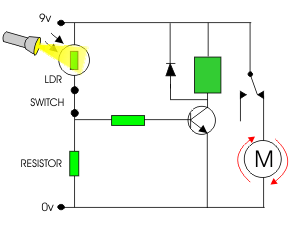
Simple Metronome With Transistors

A flip-flop, functioning as an astable multivibrator, can be utilized to generate timing signals in music applications such as a metronome. This can be achieved by adjusting the transistor bias resistor with a value of 100k.
The astable multivibrator configuration of a flip-flop consists of two transistors arranged in a feedback loop, allowing it to oscillate continuously between its high and low states. The output frequency of this circuit can be determined by the values of the timing components, which typically include resistors and capacitors connected to the transistors.
In this specific application, the 100k resistor plays a critical role in setting the biasing point of the transistors, effectively controlling the charging and discharging time of the timing capacitor. By modifying this resistor, the oscillation frequency can be adjusted, which is essential for tuning the metronome to the desired beats per minute (BPM).
The circuit can be designed with additional components such as diodes to protect against reverse polarity and capacitors to filter out noise, ensuring stable operation. The output signal can drive an LED or a speaker, providing visual or auditory feedback, respectively. The design also allows for further customization by incorporating variable resistors or capacitors, enabling the user to fine-tune the timing signal according to specific requirements.
Overall, the astable multivibrator circuit using a flip-flop is a versatile solution for generating periodic timing signals, making it suitable for various applications in music and timing devices.Flip-flop, as an astable multivibrator, can be used to generate timing signal in music: metronome. By adjusting transistor bias resistor using a 100k.. 🔗 External reference
The astable multivibrator configuration of a flip-flop consists of two transistors arranged in a feedback loop, allowing it to oscillate continuously between its high and low states. The output frequency of this circuit can be determined by the values of the timing components, which typically include resistors and capacitors connected to the transistors.
In this specific application, the 100k resistor plays a critical role in setting the biasing point of the transistors, effectively controlling the charging and discharging time of the timing capacitor. By modifying this resistor, the oscillation frequency can be adjusted, which is essential for tuning the metronome to the desired beats per minute (BPM).
The circuit can be designed with additional components such as diodes to protect against reverse polarity and capacitors to filter out noise, ensuring stable operation. The output signal can drive an LED or a speaker, providing visual or auditory feedback, respectively. The design also allows for further customization by incorporating variable resistors or capacitors, enabling the user to fine-tune the timing signal according to specific requirements.
Overall, the astable multivibrator circuit using a flip-flop is a versatile solution for generating periodic timing signals, making it suitable for various applications in music and timing devices.Flip-flop, as an astable multivibrator, can be used to generate timing signal in music: metronome. By adjusting transistor bias resistor using a 100k.. 🔗 External reference





